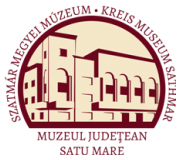Marta, Liviu (szerk.): Satu Mare. Studii şi comunicări. Seria arheologie 26/1. (2010)
Nagy József-Gábor - Körösfői Zsolt: Early Iron Age Storage Pit at Porumbenii Mari-Várfele (Harghita County)
Early Iron Age Storage Pit at Porumbenii Mari-Várfele (Harghita County) from Porumbenii Mari.34 Horia Ciugudean, analyzing the vessels with biconical bodies - based on the size and morphological characteristics - created several subtypes35. The type of vessels36 generally referred to in the literature as “Villanova-Ums”, were determined as la type, mentioned in the writing from 1991, 3A type in Attila László’s 1994 monograph and the la type in Claudia Pankau’s thesis.37 The same category includes the larger vessels from Porumbenii Mari, with outcurved rim, cylindrical neck, biconical, rounded body (Figure 3/1; Figure 4/1 ;38 Figure 5/1, 5) and the medium vessels with arched neck and prominent belly (Figure 3/2). There are two stray finds originating from the surface collection that are similar to the vessels described above (Figure 5/2, 3). As the characteristic ornaments of the urns, with polished surface, black outside and brick-red or greyish-brown inside, can be mentioned the knobs and embossment situated on the upper part of the body surrounded by semicircular channelling, the garland grooves on the upper part of the body and the vertical channelling on the belly of the vessels. The ornaments realized by garland channelling placed on the neck and associated with horizontal grooves is a typical decoration pattern for the Bz D - Ha A period39. The origin of the vessels with widely outcurving rim, high cylindrical neck and prominent belly, present in the pot making from Porumbenii Mari, should be looked for in a large geographical area, in the Igriţa, Lăpuş and Pilinyi cultural areas.40 In the second phase of the Gáva culture41 in the Upper Tisza area, the vessels with biconical body went trough form changes: the handles and bosses below the rim disappeared and the channeling of the neck became sporadic. This process was also displayed by the frequent use of the fluting and tubular handles on the upper part of the vessel.42 The presence of the biconical vessels and generally of the Gáva pottery types in the Carpathian Basin was placed in the period from the end of the 11—10th century B.C.43 Numerous analogies could be mentioned for the large vessels from Porumbenii Mari in the Transylvanian Early Iron Age settlements.44 The vertical (Figure 5/2, 4) and oblique (Figure 5/1) channelling are characteristic ornament of the globular vessels with prominent body. As a general observation in the Reinecke Ha B period the smaller upper part of the vessels were decorated with oblique channelling. This was characteristic mostly of the pottery discovered in the Lower Course of the Mureş River and Banat.45 The lb type, being determined in the interpretation of the pottery findings from Teleac by Horia Ciugudean has a similar shape as the previous la type, being only different in 34 In Transylvania there is an early start in the research of materials similar to the Gáva Culture finds, for example an urn from Târgu-Mureş published by István Kovács could be mentioned (Kovács 1915, 248/22). 35 Vasiliev et al. 1991,80-82. 36 In the analysis of vessel types I used the typology established by Horia Ciugudean (Vasiliev et al. 1991, 80-82), Attila László (László 1994, 75-77) and Claudia Pankau (Pankau 2004, 52). 37 Pankau 2004, TypenTafel 2/la. 38 There are analogies in the “Gáva-Holihrady” cultural area at: Reci-Telek (Zaharia 1965, fig. 11/12; RepCov 1998, 269, Pl. XIII/1-2); At the fortified settlement from Cernat-Hegyes-tető, dated in the Reinecke Ha B period, archaeological researches were made by Zoltán Székely in 1961, 1963 and 1980 (RepCov 1998, 70, Xllb, 13/180; Székely 2007, 70- 79, 134, 8 ábra). In 1963 he unearthed a pit house in trench no. 2. Near the fireplace he discovered a large, well smoothed, black coloured vessel with cylindrical neck and rounded biconical body, decorated with garland channelling and a knob (Székely 1983, 145, fig. 2/6, 146, fig. 4). In the repertory is wrongly mentioned as Ghidfalău (RepCov 1998, 269, pl. XIII/4; Méder 2006, 51/2; Székely 2007, 72-73, 136, 10 ábra; Méder 2008, 46/2); Poian-Köhát (Méder 2006, 56, 3/2; Méder 2008, 52, taf. 3/2); Siret-Dealul Ruina (László 1976, 74, nr. 67; Niculicá 2007), Grăniceşti (László 1994, 245-46, fig. 25-26); Hódmezővásárhely-Kopáncs XI. dűlő in pit no. V a typologically similar vessel without bosses (V. Szabó 1996, 86, 31/1, V. Szabó 2004, 110, 10/4). 39 Vasiliev et al. 1991,80-81; Boroffka 1994,9-18. 40 Vasiliev et al. 1991,80. 41 Dated by T. Kemenczei in the Ha A2-B, (Kemenczei 1984, 96). 42 Patay 1976, 193-196. 43 Vasiliev 2008, 13-14. 44 Mediaş (Zaharia 1965, fig. 5/1-3, 8/2-3), Reci-Telek (Székely 1966, pl. II/4, III/4, IV/3; RepCov 1998, 269, pl. XIII/2), Teleac (Vasiliev et al. 1992, 228, fig. 32/1; Vasiliev et al. 1992, 225, fig. 29/2.); Cérnát (Székely 1983, 145, fig. 2/6, 146, fig. 4; RepCov 1998, 269, pl. XIII/4). 45 László 1973, 595. 137
